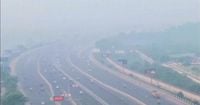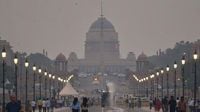Five days after the festival of Diwali, a stark contrast has emerged between Indian cities as they grapple with the aftermath of the country’s most celebrated holiday. While Bengaluru enjoys some of the cleanest air among major metros, Delhi remains shrouded in a thick, hazardous smog, raising urgent concerns for public health and city management. The numbers tell a dramatic story: on October 25, 2025, Bengaluru recorded an Air Quality Index (AQI) of just 32—a reading that would make even the world’s cleanest cities envious. Hyderabad and Chennai also reported healthy AQIs of 45 and 56, respectively. Meanwhile, Delhi’s AQI soared to 336 on the same morning, placing it firmly in the ‘very poor’ category, according to Mathrubhumi and data from the Central Pollution Control Board (CPCB). Ahmedabad was the only other major city to report unhealthy air, with AQI levels exceeding 150.
The festival of Diwali, celebrated this year in New Delhi from October 18 to 22, is renowned for its vibrant lights and the spirit of new beginnings. Yet, as blue News and other outlets observed, the aftermath has a darker side. Despite official bans on fireworks, the bursting of firecrackers remains widespread, and the consequences are visible—and tangible. During the festival, particulate matter levels in New Delhi spiked to 50 times the normal level, enveloping the city in a dense, choking smog. Residents reported symptoms ranging from watery eyes to shortness of breath, as the city’s air quality plummeted to dangerous lows. The festival, embraced by Hindus, Sikhs, Jains, and Buddhists alike, may symbolize hope and unity, but the environmental fallout is impossible to ignore.
According to reports from PTI and corroborated by health experts, the days immediately following Diwali—October 20 to 23—brought a sharp and worrying rise in hospital visits across Delhi-NCR. Outpatient and emergency departments saw a surge in respiratory and pregnancy-related complications. Doctors across the region attributed this spike directly to the combined effects of air and noise pollution from the relentless bursting of firecrackers, particularly during late-night hours. Dr. Pulkit Agarwal, Consultant Pulmonologist at SilverStreak Superspeciality Hospital, told PTI, “The post-Diwali smog is particularly dangerous because it comes with a sudden, dense concentration of pollutants. We’ve seen a nearly 30 percent jump in patients with breathing difficulties, asthma flare-ups, and allergic bronchitis within just two days after Diwali.”
His concerns were echoed by Dr. Mohit Bhardwaj, Consultant Pulmonology at Shalby International Hospital, Gurugram, who explained, “The combination of stagnant winter air and smoke from crackers traps pollutants close to the ground. People with pre-existing conditions must avoid outdoor exposure during peak pollution hours, wear N95 masks, and continue prescribed inhalers or medications without interruption.” The elderly, children, pregnant women, and those with chronic respiratory or cardiac illnesses have been particularly hard hit, struggling to cope with the toxic air.
Gynaecologists have raised alarms about the less visible but equally serious risks to maternal and fetal health. Dr. Astha Dayal, Director of Obstetrics and Gynaecology at CK Birla Hospital, Gurgaon, explained, “High levels of particulate matter can cross the placental barrier and interfere with fetal growth and brain development. We have observed an increase in expectant mothers reporting shortness of breath, dizziness, and elevated blood pressure following Diwali festivities.” Dr. Yashica Gudesar, Director and Unit Head of Obstetrics and Gynaecology at Max Super Speciality Hospital, Dwarka, added, “Continuous exposure to polluted air during pregnancy could also raise the risk of preterm birth and low birth weight. We advise pregnant women to stay indoors when air quality dips, use air purifiers at home, and increase fluid intake to flush out toxins. Working women should also ensure the use of air purifiers at home, in their offices, and even in cars to minimize continuous exposure to harmful pollutants.”
The numbers are sobering. After Diwali, PM2.5 levels in Delhi peaked at 675—a four-year high. For context, the AQI system classifies scores between 0 and 50 as ‘good,’ 51–100 as ‘satisfactory,’ 101–200 as ‘moderate,’ 201–300 as ‘poor,’ 301–400 as ‘very poor,’ and 401–500 as ‘severe.’ On October 25, Delhi’s AQI improved slightly to 261, shifting from ‘very poor’ to the ‘poor’ category, but the improvement was marginal and the air remained hazardous. Seven monitoring stations still recorded air quality in the ‘very poor’ range, with the rest only slightly better.
In response to the crisis, Delhi authorities activated anti-smog measures, including spraying water with anti-smog guns in an effort to settle airborne particles. Yet, these interventions offer only temporary relief. Health officials and experts have repeatedly called for more responsible and sustainable ways to celebrate festivals. Their recommendations are clear: switch to eco-friendly crackers, organize community firework displays instead of individual ones, and promote quieter, greener celebrations. As Dr. Pulkit Agarwal emphasized, “Preventive care, public awareness, and responsible celebration are the only ways to break this recurring post-Diwali health emergency.”
Meanwhile, the story in Bengaluru could not be more different. The city, often challenged by traffic-related pollution throughout the year, has experienced a rare clean-air phase post-Diwali. With an AQI reading of 32 on October 25, residents are enjoying a temporary reprieve from the pollution woes that plague other metros. Health officials in Bengaluru have advised residents to monitor air quality, especially vulnerable groups like children and the elderly, but they also note that outdoor activities such as walking, jogging, and cycling are currently safer than in other major cities. Experts caution, however, that Bengaluru’s clean air may be fleeting, as seasonal changes and urban emissions could still affect the city’s air quality in the coming weeks.
Hyderabad and Chennai have also fared well, with AQIs of 45 and 56, respectively, reflecting lower post-festive pollution and offering residents a safe environment for outdoor activities. Ahmedabad, by contrast, was the only other major city besides Delhi to report unhealthy air levels above 150.
The annual post-Diwali pollution crisis in Delhi is not new, but the scale of the health impact this year has renewed calls for change. Medical professionals and environmentalists stress that only a combination of stricter enforcement, public cooperation, and cultural adaptation can address the root of the problem. As the winter months approach and the lingering effects of firecracker-related pollution fade, cities like Bengaluru remain a bright spot—at least for now—in India’s ongoing battle for clean air.
For millions of Indians, Diwali will always be a time of celebration and hope. But as the smog settles over Delhi and the clean air in Bengaluru offers a rare moment of relief, the contrast serves as a stark reminder: how festivals are celebrated can have real, lasting consequences for public health and the environment.





